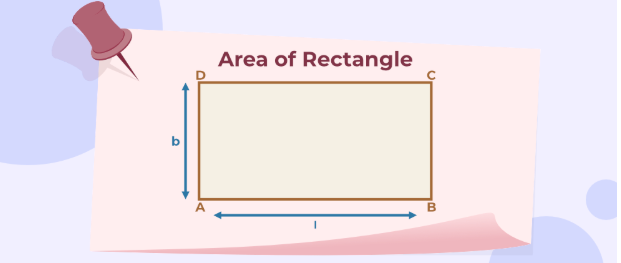The area of a rectangle is one of the most basic and useful concepts in math. It is the space inside the rectangle’s shape. You can find it with a simple formula, and it is used in many real-life situations. From building houses to making gardens, knowing how to calculate the area of a rectangle is very helpful.
In this article, we will explain what a rectangle is, how to find its area, and give you many examples. We will also answer common questions so that you can understand this topic completely.
Table of Contents
What Is a Rectangle
A rectangle is a four-sided shape (quadrilateral) with opposite sides equal and all angles at 90 degrees. This means:
- It has two long sides and two short sides.
- All four corners are right angles.
- Opposite sides are parallel.
Examples of rectangles in daily life include books, tables, doors, computer screens, and whiteboards.
The rectangle is special because it’s easy to measure and calculate its area.
Understanding the Area of a Rectangle
The area of a rectangle tells us how much space is inside the shape. Think of it as counting how many small squares can fit inside the rectangle.
For example:
If each small square is 1 cm² and there are 20 squares inside, the area is 20 cm².
The bigger the length and width, the larger the area. If you double the size of both sides, the area becomes four times bigger.
Formula for Area of a Rectangle
The formula is simple:
Area = Length × Width
- Length (L) is the longer side.
- Width (W) is the shorter side.
Example:
If a rectangle has a length of 8 cm and a width of 5 cm:
Area = 8 × 5 = 40 cm²
This formula works for all rectangles, no matter how big or small they are.
How to Calculate the Area Step-by-Step
Let’s go through the steps:
- Measure the length – Find the distance of the longer side.
- Measure the width – Find the distance of the shorter side.
- Multiply length by width – Use the formula to get the area.
- Write the units – If measured in cm, the result is in cm².
Example:
Length = 12 m, Width = 6 m
Area = 12 × 6 = 72 m²
Units for Measuring Area
The area of a rectangle can be measured in different units depending on the length and width measurement. Common units include:
- Square centimeters (cm²)
- Square meters (m²)
- Square inches (in²)
- Square feet (ft²)
Remember:
If you measure in meters, the area will be in square meters. If you measure in centimeters, the area will be in square centimeters.
Real-Life Examples of Rectangle Area
The area of a rectangle is useful in many real-life situations, such as:
- Flooring: Knowing how many tiles you need.
- Painting: Calculating the wall space to cover.
- Gardening: Measuring space for plants.
- Construction: Estimating materials for walls, windows, or doors.
- Sports fields: Measuring courts like basketball or tennis courts.
Example:
If you have a garden that is 10 m long and 8 m wide, the area is:
10 × 8 = 80 m²
Common Mistakes in Calculating Area
Some people make small mistakes when calculating the area of a rectangle. Here are the common ones:
- Mixing length and width units (e.g., length in meters, width in cm).
- Forgetting to square the units (writing “m” instead of “m²”).
- Confusing area with perimeter – The perimeter measures the distance around, not inside.
Tip: Always check that both length and width are in the same unit before multiplying.
Practice Problems for Area of a Rectangle
Here are some problems to try:
- Length = 9 cm, Width = 4 cm → Area = ?
- Length = 15 m, Width = 10 m → Area = ?
- A table top is 1.2 m long and 0.8 m wide → Area = ?
- A wall is 6 ft long and 9 ft wide → Area = ?
Answers:
- 36 cm²
- 150 m²
- 0.96 m²
- 54 ft²
Conclusion
The area of a rectangle is a simple but important concept in mathematics. By multiplying the length and width, you can find out the space inside a rectangle. This skill is useful in construction, design, sports, and everyday life. Always remember to use the same units for length and width, and don’t forget to square the unit in your final answer.
FAQs
Q1: What is the difference between area and perimeter?
The area is the space inside a shape, while the perimeter is the distance around it.
Q2: Can I find the area if I only know the perimeter?
Not directly—you need at least one side length to calculate the area.
Q3: What if the length and width are the same?
Then the rectangle is actually a square, and the formula is still Length × Width.



